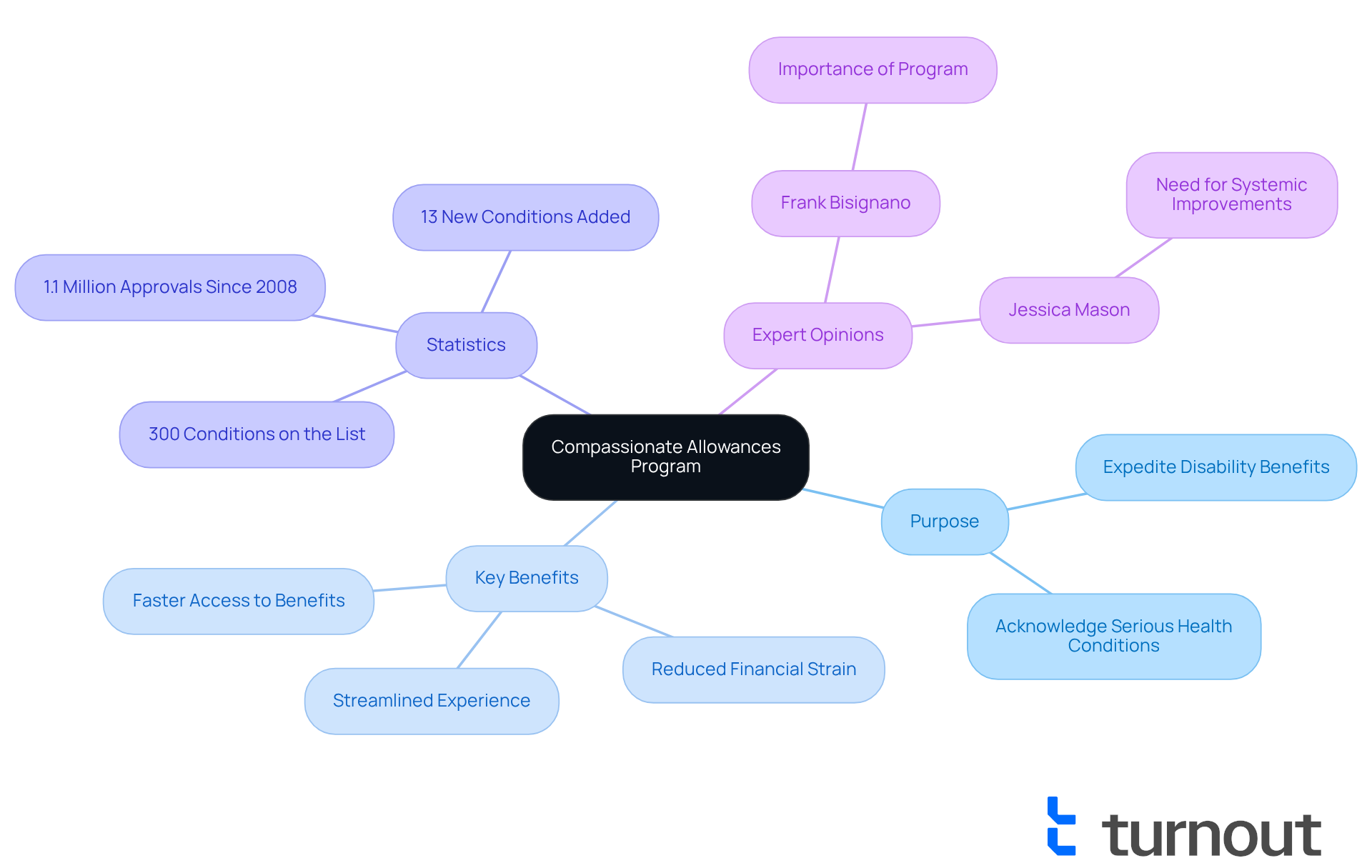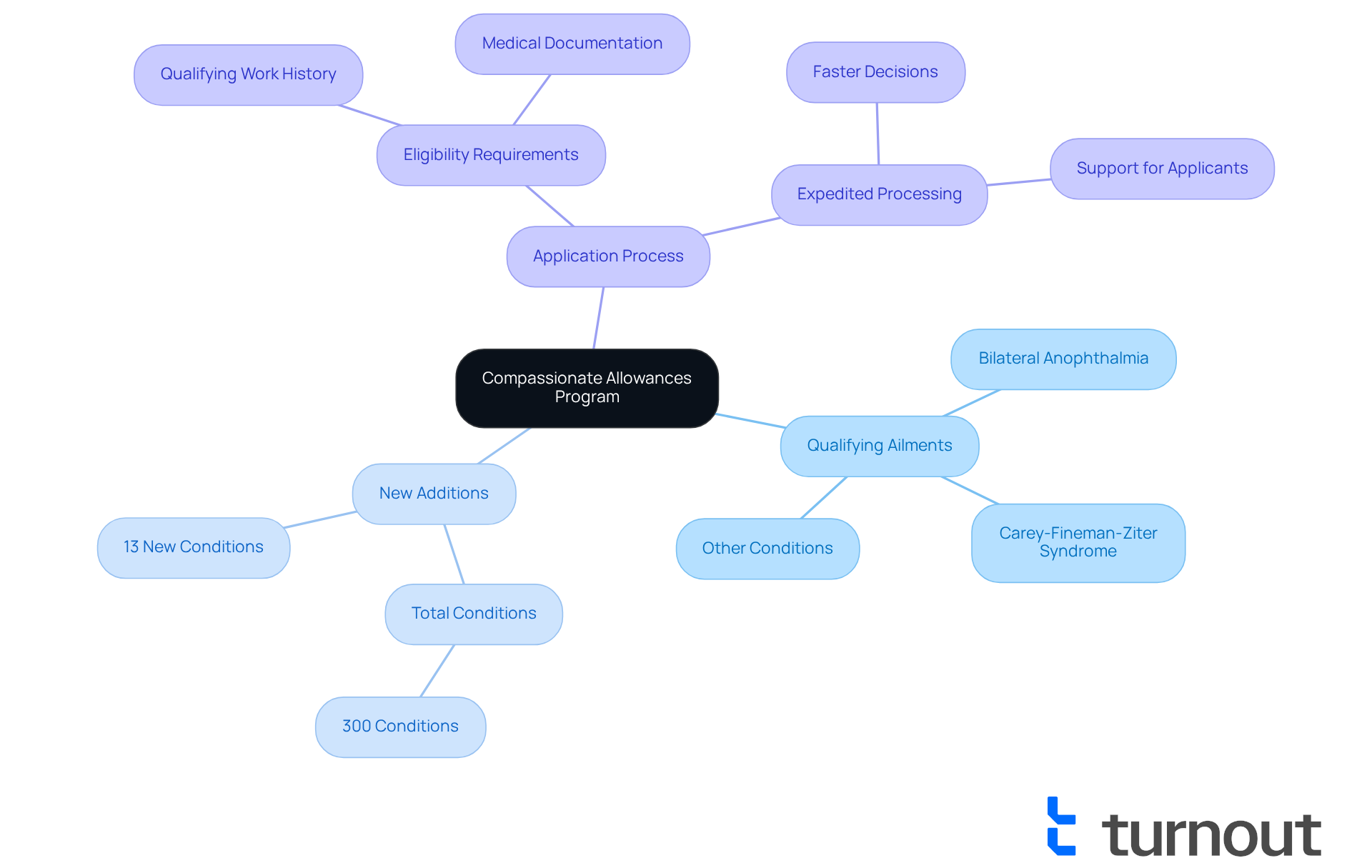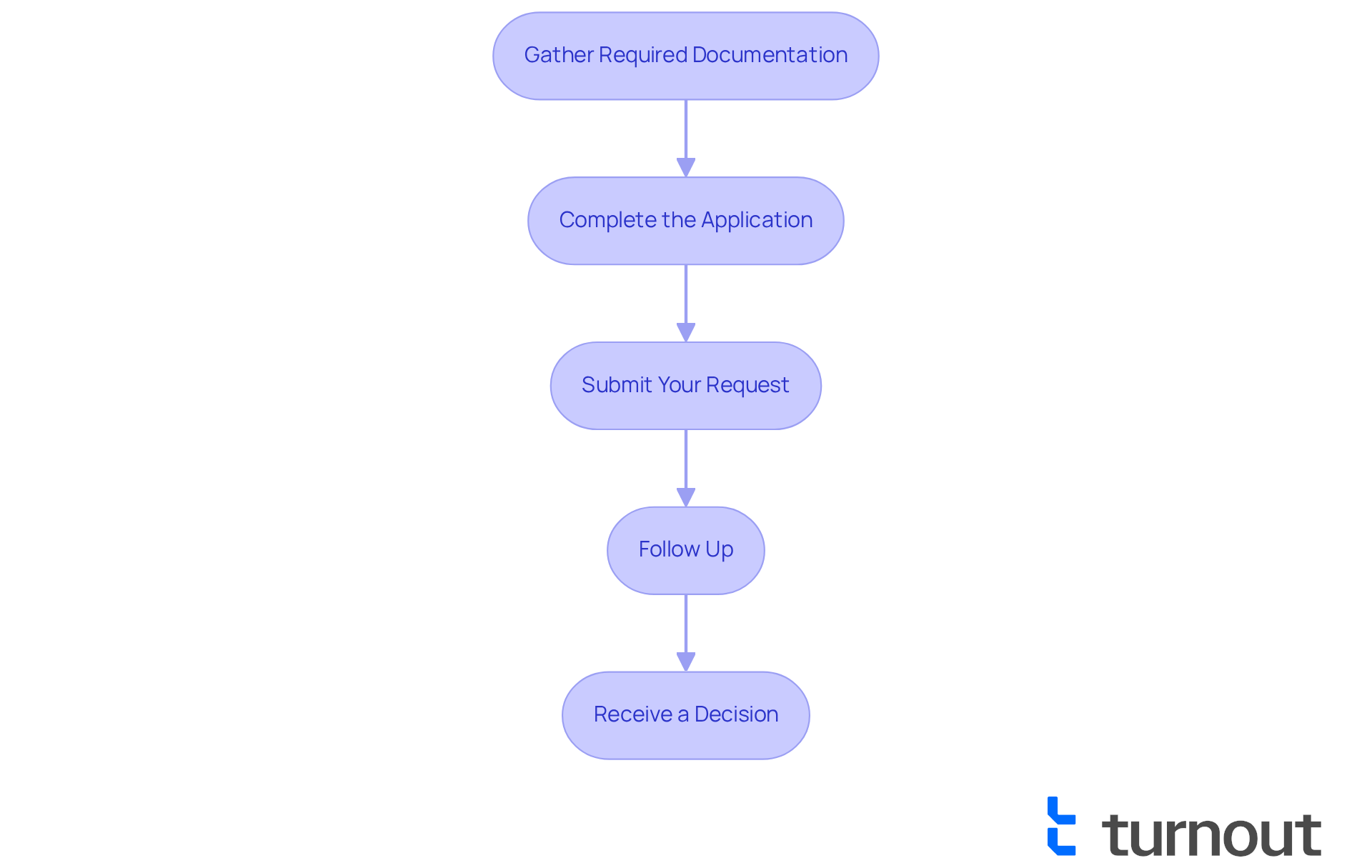Overview
Navigating the Social Security Compassionate Allowances (CAL) program can be a daunting task, especially for those facing severe health challenges. This article serves as a comprehensive guide to help you through this process, aiming to alleviate some of the burdens you may be feeling.
We understand that applying for disability benefits can be overwhelming. The CAL program is designed to expedite these benefits for individuals like you, who are experiencing significant health issues. By detailing the application process and eligibility criteria, we hope to provide you with the clarity you need to move forward.
Thorough documentation plays a crucial role in this journey. It’s important to know that by utilizing the CAL program effectively, you can significantly reduce wait times and lessen financial strain. Remember, you are not alone in this journey; we’re here to help you every step of the way.
Take a moment to reflect on your situation and consider how the CAL program may be able to support you. With the right information and preparation, you can navigate this process with confidence. We encourage you to take action and explore the resources available to you.
Introduction
Navigating the complexities of the Social Security Compassionate Allowances Program can feel overwhelming, especially for those facing severe health conditions. We understand that this essential initiative, designed to expedite disability benefits for individuals with qualifying ailments, is crucial for many. Recently, the program has expanded to include over 300 serious diseases, reflecting a growing acknowledgment of the urgent needs many people experience.
However, despite the promise of faster access to vital support, applicants often encounter challenges that can complicate the process. It’s common to feel uncertain about what steps to take. What can you do to ensure your application is successful and timely? We’re here to help you navigate this journey with confidence.
Understand the Compassionate Allowances Program
The Empathetic Allowances Program (CAL) is a vital initiative by the Social Security Administration (SSA) designed to expedite disability benefits for individuals facing serious health challenges. This program acknowledges specific diseases and conditions that align with the SSA's legal definition of disability, allowing for quicker processing of requests. As of August 2025, the Special Allowances list has grown to include 300 serious diseases and conditions, with 13 new entries added recently, such as Bilateral Anophthalmia and Harlequin Ichthyosis. This expansion reflects a commitment to recognizing the hardships faced by individuals with these severe diagnoses.
Understanding the social security compassionate allowances program is crucial for applicants. Those whose conditions qualify for social security compassionate allowances may receive benefits much faster than through the traditional process. Typically, SSDI applicants experience a five-month waiting period before payments begin in the sixth month after approval. However, the CAL initiative facilitates accelerated processing through social security compassionate allowances, often reducing the wait time for individuals meeting the qualifying criteria.
Turnout plays a significant role in simplifying access to these benefits. They provide tools and services that assist consumers in navigating the complexities of SSD claims. While Turnout is not a law firm and does not offer legal representation, their trained nonlawyer advocates are ready to help applicants understand and apply for benefits, including social security compassionate allowances, under the CAL program. This support can alleviate financial stress during the submission process and enhance the overall experience.
Frank Bisignano, the SSA Commissioner, emphasized the importance of this program, stating, "By adding these 13 criteria to the allowances list, we are assisting more individuals with severe diagnoses to swiftly obtain the support they require." This highlights the SSA's ongoing efforts to enhance the disability determination process and serve the public more effectively.
Jessica Mason, a senior policy analyst for economic justice, offers a critical perspective. She notes that while changes like the CAL initiative may provide assistance, they are insufficient without significant investments in Social Security infrastructure and a stronger safety net for disabled individuals.
Real-world success stories illustrate the program's impact. Since its inception in 2008, over 1.1 million individuals with severe disabilities have been approved through the expedited process, showcasing the program's effectiveness in delivering timely assistance to those in urgent need.
For applicants, the key benefits of the Compassionate Allowances Program include:
- Faster access to benefits
- Reduced financial strain during the application process
- A more streamlined experience
The SSA encourages individuals who believe they have a CAL issue to apply online at SSA.gov, which can further minimize delays and improve the overall experience. It is also essential for applicants to understand that eligibility for SSDI still depends on a qualifying work history and the inability to work due to their condition.

Identify Eligible Conditions for Compassionate Allowances
To assess your eligibility for the Compassionate Allowances Program, we understand that the first step is to verify if your medical issue is listed among the qualifying ailments maintained by the Social Security Administration (SSA). As of August 2025, this list has grown to include over 300 ailments, covering a range of conditions such as various cancers, adult brain disorders, and rare genetic disorders. Importantly, the SSA has added 13 new circumstances this year, demonstrating a commitment to recognizing the challenges faced by individuals with serious health problems.
For instance, conditions like Bilateral Anophthalmia and Carey-Fineman-Ziter Syndrome are now acknowledged, primarily affecting children and highlighting the program's focus on urgent needs. You can view the full list of qualifying circumstances on the SSA's official website. If your situation is not mentioned, please don't lose hope; you can still submit an application. However, it’s important to note that it will not be processed under the expedited allowances criteria.
Remember, while the qualifying criteria typically involve severe, life-threatening, or profoundly disabling diagnoses, you must still present suitable medical documentation to support your claims. You are not alone in this journey, and we’re here to help you navigate through these challenging times.

Follow the Step-by-Step Application Process
Applying for benefits under the Compassionate Allowances Program can feel overwhelming, but we’re here to help you through the process. Follow these steps to ensure you’re on the right track:
- Gather Required Documentation: Start by collecting all necessary medical records that confirm your diagnosis. This includes detailed reports from your healthcare providers, treatment plans, and any relevant test results. Having everything in order can make a significant difference.
- Complete the Application: You can apply online through the SSA website, by phone, or in person at your local SSA office. It’s important to clearly indicate that your condition is on the Compassionate Allowances list, as this can expedite processing and provide you with the support you need sooner.
- Submit Your Request: After completing the request, send it along with your medical documentation. Remember to keep copies of everything you send for your records; this can be reassuring in case you need to refer back to it.
- Follow Up: After submission, keep an eye on the status of your request. You can check online or contact the SSA directly. If additional information is requested, respond promptly to avoid any delays in processing. We understand that waiting can be stressful, but staying informed helps.
- Receive a Decision: If your application is approved, you will receive notification from the SSA regarding your benefits. If denied, remember that you have the right to appeal the decision. Guidance is available to help you navigate this process, and you are not alone in this journey.
Statistics show that Compassionate Allowances claims are often approved within 10-14 days, significantly faster than standard claims, which can take 3-5 months. Proper preparation and thorough documentation are key to minimizing the risk of denial. Claims are rarely denied when all necessary paperwork is included. Denials typically occur due to missing paperwork, unclear medical documentation, or lack of confirming test results. Real-world instances emphasize that candidates who explicitly outline their qualifying circumstances and offer thorough medical documentation possess a greater success rate. By adhering to these steps, you can help ensure a more seamless procedure and faster access to the benefits you require.

Access Resources and Tips for a Successful Application
To increase your chances of a successful application for Compassionate Allowances, consider these supportive tips:
- Utilize Available Resources: We encourage you to leverage resources such as the SSA's official website, which offers comprehensive information about the application process and eligible conditions. Additionally, organizations like Turnout provide expert advice and support to help you navigate the enrollment process, making it easier to access government benefits and financial aid. Please remember, Turnout is not a law firm and does not provide legal advice.
- Be Thorough with Documentation: It's essential to ensure that all medical records are complete and clearly demonstrate your condition. Incomplete documentation can lead to delays or denials, as the SSA requires thorough evidence to support your claim. Having a well-organized set of medical records can significantly enhance your chances of a successful claim.
- Stay Organized: Keeping all your submission materials arranged and easily accessible can be incredibly helpful. This organization will assist you in responding swiftly to any requests for further information from the SSA, which can help accelerate your process.
- Seek Support: If you feel overwhelmed, please consider reaching out to a disability benefits advocate, such as those provided by Turnout. They can offer personalized assistance and help you navigate the process more effectively. Skilled representatives can assist in collecting essential medical evidence, which is vital for your submission.
- Stay Informed: We understand that staying updated can be challenging. Regularly check for updates on the Special Allowances list and any changes to the application process by visiting the SSA website. As of 2023, there are now 300 entries on the list, reflecting the SSA's dedication to addressing urgent needs.
- Highlight Your Situation: When applying, clearly indicate that your situation is on the Compassionate Allowances Conditions list. This can significantly reduce the approval time. Many applicants receive decisions in about 10 days instead of the standard months-long wait. As noted by Jen Teague, this process serves as a "fast-track to disability benefits."
- Document Daily Activities: Providing detailed accounts of how your condition affects your daily life is crucial. This information can help claims examiners understand the severity of your situation, which is essential for a successful application.

Conclusion
The Compassionate Allowances Program is a vital lifeline for individuals grappling with severe health issues. It streamlines the process of obtaining much-needed disability benefits. By recognizing over 300 qualifying conditions, including newly added ailments, the program demonstrates a significant commitment to alleviating the distress faced by those diagnosed with serious illnesses. Understanding this initiative is essential for applicants who wish to expedite their benefits and ease the financial burden during their application journey.
In this guide, we have shared key insights, such as:
- The importance of thorough documentation
- The step-by-step application process
- The vital role of resources like Turnout in assisting applicants
With claims often approved within 10-14 days, the Compassionate Allowances Program not only provides faster access to benefits but also fosters a more manageable experience for those in urgent need. Real-world success stories illustrate the program's effectiveness in delivering timely support to millions.
Recognizing these insights, it is crucial for potential applicants to take proactive steps in navigating the Compassionate Allowances process. By staying informed, utilizing available resources, and ensuring thorough documentation, individuals can enhance their chances of a successful application. The Compassionate Allowances Program is not merely a bureaucratic process; it embodies a vital support system designed to help those facing life-altering challenges regain stability and hope. You are not alone in this journey, and we’re here to help you every step of the way.
Frequently Asked Questions
What is the Compassionate Allowances Program (CAL)?
The Compassionate Allowances Program (CAL) is an initiative by the Social Security Administration (SSA) designed to expedite disability benefits for individuals with serious health challenges by allowing quicker processing of requests for specific diseases and conditions.
How many diseases and conditions are included in the CAL list as of August 2025?
As of August 2025, the CAL list includes 300 serious diseases and conditions, with 13 new entries recently added.
What are some examples of newly added conditions to the CAL list?
Newly added conditions to the CAL list include Bilateral Anophthalmia and Harlequin Ichthyosis.
How does the CAL program benefit applicants compared to the traditional disability benefits process?
The CAL program allows qualifying individuals to receive benefits much faster than the traditional process, significantly reducing the typical five-month waiting period before payments begin.
What role does Turnout play in the application process for CAL?
Turnout provides tools and services to assist consumers in navigating the complexities of SSD claims, helping applicants understand and apply for benefits under the CAL program, although they do not offer legal representation.
What did Frank Bisignano, the SSA Commissioner, say about the recent additions to the CAL list?
Frank Bisignano emphasized that adding 13 criteria to the allowances list helps more individuals with severe diagnoses swiftly obtain the support they require.
What concerns did Jessica Mason, a senior policy analyst, express regarding the CAL initiative?
Jessica Mason noted that while the CAL initiative provides assistance, it is insufficient without significant investments in Social Security infrastructure and a stronger safety net for disabled individuals.
How many individuals have been approved through the CAL program since its inception in 2008?
Since its inception in 2008, over 1.1 million individuals with severe disabilities have been approved through the expedited process of the CAL program.
What are the key benefits of the Compassionate Allowances Program for applicants?
The key benefits include faster access to benefits, reduced financial strain during the application process, and a more streamlined experience.
How can individuals apply for benefits under the CAL program?
Individuals who believe they have a CAL issue are encouraged to apply online at SSA.gov to minimize delays and improve their overall experience.
What are the eligibility requirements for SSDI under the CAL program?
Eligibility for SSDI still depends on having a qualifying work history and the inability to work due to the individual's condition.




